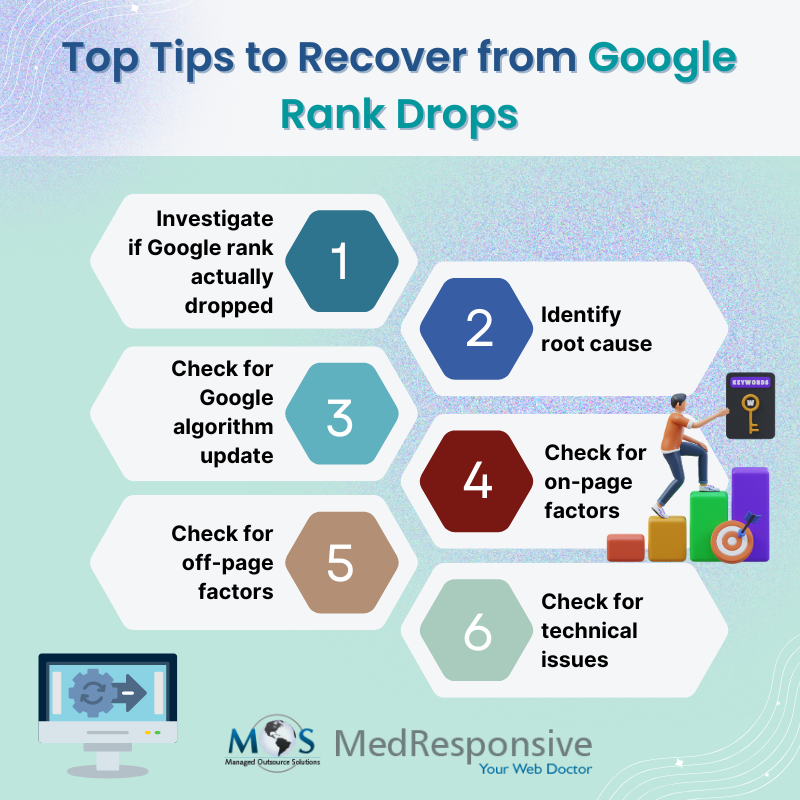For independent bloggers and entrepreneurs, digital success largely depends on having a highly ranked website. The primary objective of a website is to deliver relevant and valuable content to users. High SERP ranking is necessary for website owners to achieve their online marketing goals, such as enhanced online visibility, organic traffic, sales growth, and global reach.
It is therefore no surprise that site owners can feel devastated by the sudden drop in Google ranking. However, finding the root cause of the dramatic drop in rankings and fixing them as soon as possible can be really challenging. It is important to navigate this issue with caution, wisdom, and right judgment to diagnose the problem and implement corrective solutions. SEO is an ongoing process that requires consistent time and effort, which is why hiring a search engine optimization company is a practical option.

Actionable Steps to Address and Recover from Google Rank Drops
Rebounding from a Google ranking drop can be challenging, but with the right strategies, it’s possible to recover and improve your site’s performance over time. Here are some steps you can take to recover your lost ranking:
- Verify If Google Rank Actually Dropped
Before taking any drastic measures, use SEO tools such as Moz, Google Analytics, or Google Search Console to verify whether the rank decline was a short fluctuation or a major drop. It is important to remember that temporary rank drops may happen due to external factors, such as an algorithm update. A practical approach is to wait for a while and track your site’s performance after a period of two weeks to see if it has gone back to its original ranking or not. To verify if it was an actual drop or not, consider performing an SEO audit:
- Run a crawl of your website
- Track site performance with KPIs such as total impressions, average CTR, and position.
- Check for indexing issues
- Verify organic traffic rate
- Ensure SEO best practices are followed
Once it is confirmed that your Google rank has dropped, the next step is to identify the root cause for the decline.
- Identify the Root Cause
If your site did indeed experience rank decline, then the next essential step is to determine if it was a sudden or gradual decline. An unexpected drop may happen due to several reasons:
- Algorithm updates
- Penalty
- Major changes made recently to the website
- Technical issues
If you notice the deterioration in SEO rank was gradual, it may be due to:
- Outdated or neglected SEO efforts
- Content slump
- Ignoring local SEO
- Website domain name or hosting has expired
When you analyze the site’s performance, try to pinpoint exactly what happened and the extent of the situation by tracking user behavior and traffic patterns over a specific period of time in Google Search Console report. Notable SERP fluctuations can be caused by several factors, such as algorithm updates, technical issues, or losing the spot to competitors. To identify the root cause, you need to determine if the poor performance is specific only to certain sections or pages of the website or if it has impacted the entire website. You can use Google search console for this purpose and narrow down the faulty pages from the page indexing section. If only certain parts of your website are affected, then focus on optimizing only the affected pages of your site to improve rankings and online visibility.
- Check for Google Algorithm Update
One of the most common reasons behind ranking fluctuations is Google algorithm updates as they reevaluate websites based on new criteria and standards. Frequent updates to the search engine algorithms are made almost every day, with the intent to preserve the quality of the search results. However, major updates such as broad core updates or helpful content updates can significantly affect your website ranking. So if you don’t stay updated with Google’s algorithm changes, and your site doesn’t measure up to the latest ranking factors, it may lead to a dip in SEO rankings.
You can follow the given steps to determine if it was an algorithm update that affected your website:
- Go through the Google search status dashboard to see information about the latest Google updates.
- Verify whether the ranking drop coincides with the update and identify the purpose of this update to understand why your website may get affected.
- Algorithmic updates can result in Google penalties due to violation of its policies. Head over to Google search console and check if your site received a manual action. A few examples of manual actions include:
- User-generated, third-party, and other types of spam
- Hidden text and keyword stuffing
- Unnatural links to and from your site
- Thin content
- Cloaking and sneaky redirects
- Check for On-Page Factors
Your site’s performance in the search results may be a matter of issues with on-page elements, such as:
- Content Quality – Evaluate the quality of your content to assess whether it follows the Google policy of user value by ensuring all the information is relevant, helpful, and accurate. Stay updated with the user interests and measure content relevance with tools such as Google Trends and adjust your strategy accordingly. Review the content carefully and go through the following steps to verify the quality of your content:
- Update or delete old existing content with the latest information by adding relevant keywords, updating statistics, and removing outdated data.
- Remove duplicate and thin content that was created for search engines instead of users.
- Refrain from over-optimization tactics such as keyword stuffing or hidden links that may dampen your site’s credibility and authority.
- User Experience – Search engines are driven by the user interests and intent, so if your site is simply not furnishing high-quality user experience anymore, it will result in low rankings. You can check for user experience by analyzing key metrics such as bounce rate, conversion rate, and organic traffic. Enhance the UI/UX elements of your website by implementing personalization, feedback mechanisms, and accessibility features for an inclusive user experience.
- Meta tags – Meta tags such as meta descriptions and meta title tags are basic but core components of a website and have a direct impact on metrics such as click-through rates. Missing or duplicate meta tags can negatively impact a website’s ranking, so optimizing them is crucial to promote your website. Add short and unique content to them with relevant keywords that accurately represent the site’s content.
- Check Off-Page Factors
Off-page elements are critical for driving traffic and conversions to your website. A few of the off-page elements influencing rank drop are:
- Links analysis –Link building forms a strong part of SEO practices, and you should maintain a healthy internal linking structure and backlink profile to boost SEO. Identify and repair any broken, toxic, and lost backlinks and prioritize quality over quantity by removing negative backlinks.
- Social media signals – Although they are not a direct ranking factor, social signals can impact traffic and brand popularity, indirectly affecting SEO. Interact more with online users by liking, sharing, and commenting on social media posts to boost engagement.
- Local SEO signals – Optimize local SEO elements such as reviews, Google Business Profile, and local citations to enhance online visibility. Ensure NAP consistency (Name, Address, and Phone Number) across all listings.
- Competitor analysis – A drop in ranking doesn’t always necessarily mean anything is wrong with your website, but rather your competitors have gone ahead of you in the position. Identify direct and indirect competitors and analyze their SEO strategies to find out why they are outperforming your site. Use competitor analysis tools such as semrush to identify gaps and areas of improvement. Regular analysis will help you to stay ahead of the curve.
- Check for Technical Issues
Technical glitches such as server errors, broken links, and outdated sitemaps may lead to poor website performance in the SERP. Poor technical performance may lead to crawl and index errors, impacting your website. Running a site audit is essential for discovering technical issues, such as:
- Slow page speed – Improve page load speed to better user experience, leading to a surge in search rankings. Optimize media elements, enhance code quality, and use CDN to improve loading times.
- Mobile optimization – Google prioritizes mobile-first indexing, so ensure that your mobile version is responsive to be functional on devices of types.
- Crawlability and indexability – Boost your site’s crawlability and indexability to ensure your web pages are visible to search engines during the indexing and ranking process. Fix technical issues in website elements such as robots.txt file errors, 404 error pages, and canonical tag errors to ensure your website is properly crawled and indexed.
- Hacking –Websites are vulnerable to a variety of cybersecurity threats, and you can find out if your site is hacked by viewing “security issues” in the search console. Other indications for hacked sites include password reset request emails, alerts from hosting providers, and unusual redirects. Implementing strong password protection, maintaining a backup version, and installing an SSL certificate are a few of the security measures that can be executed for mitigating future cyber-attacks.
Climb Back Up
When it comes to SEO, consistency is the key towards unlocking increased search visibility, traffic, and ranking of your website. Recovering from the downslide in search ranking depends on a combination of strategic planning involving data, industry context, and proactive SEO testing methodologies. Although a sudden crash in Google ranking can be a daunting experience, consistent and prompt SEO efforts can contribute to the recovery and prolonged success of your website.
Regularly monitoring your SEO performance in the SERP is crucial to gauge the effectiveness of your SEO strategies. Devising a tailored website optimization plan based on your particular SEO requirements, while staying on top of evolving industry trends and user behavior will ensure you stay high on the SERP. Professional SEO services can help businesses implement proactive strategies to improve their ranking, conversions, and revenue.




